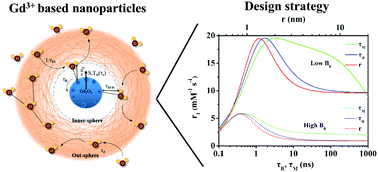A design strategy of ultrasmall Gd2O3 nanoparticles for T1 MRI with high performance†
Abstract
It is still a big challenge to design Gd3+ based nanoparticles (NPs) for T1 MRI (Magnetic Resonance Imaging) with high performance and clarify the effects of relative time parameters on longitudinal relaxivity r1. In this paper, we simulated the influences of different time parameters on the longitudinal relaxivity of Gd3+ based NPs with inner-sphere and outer-sphere theories, respectively. In particular, we investigated the effects of τR (the rotational time), τM (the residence time), Tie (the electronic relation time) and τd (the diffusion time) on longitudinal relaxivity. In the relaxation process of Gd3+ based NPs, the inner-sphere plays a dominant role, in which τR and τM have a greater impact on r1. Based on the simulation results, we proposed a design strategy of Gd3+ based NPs for T1 MRI, which focuses on the rational decrease of hydrated radius, and the optimal range of the hydrated radius is about 0.8–2.5 nm. In addition, we synthesized ultrasmall Gd2O3 NPs with a hydrated radius of about 2.5 nm, which have a high longitudinal relaxivity r1 of 10.8 mM−1 s−1 at 3.0 T. Moreover, the in vivo imaging results confirm that the ultrasmall Gd2O3 NPs have a good imaging effect on the tumor, and it can be a good candidate as a T1 MRI contrast agent with high performance.



 Please wait while we load your content...
Please wait while we load your content...